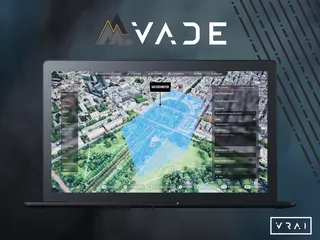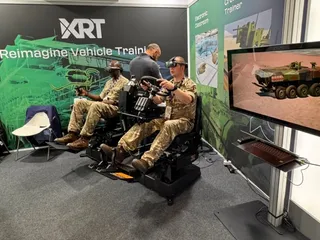RealitySeven™ Update
Contact Our Team
For more information about how Halldale can add value to your marketing and promotional campaigns or to discuss event exhibitor and sponsorship opportunities, contact our team to find out more
The Americas -
holly.foster@halldale.com
Rest of World -
jeremy@halldale.com

Marty Kauchak and Chris Long learn more about Link Simulation & Training UK’s modular training device concept.
Link Simulation & Training UK is going beyond advancing the state-of-the-art in full flight simulators (FFS) with its RealitySeven device. With a proven platform that can replicate a wide range of aircraft types, Link emphasizes its ability to also provide returns on investment (ROI) and other efficiencies, and modify the business model for civil aviation RealitySeven customers.
Introduced in 2009, Link has delivered 23 RealitySeven FFSs to customers around the globe. A partial list of this FFSs customers includes Aeroflot, Airbus Training, Sichuan Airlines, Hua-Ou Aviation Training, Eva Airways, and Boeing Flight Services. Another 10 RealitySeven FFSs are on order.
David White, Link’s Chief Scientist, told Group Editor Marty Kauchak during WATS 2014, this FFSs’ common components remain the visual module, docking station and motion system.
The visual module’s field of view is in excess of 200(H) x 45(V), according to the company’s product brochure. “We have actually built it to allow for the projectors to increase their resolution – to 225[H] and even 50[V],” White noted.
Link’s design strategy for the visual module remains projector agnostic, allowing the OEM/end user to select best-of-breed projector solutions.
The aircraft module, reproduced to the fidelity of increasing types of aircraft cockpits, is manufactured specific to the aircraft being simulated.
Enhancements
The recent technology enhancements have allowed key RealitySeven components to remain generic. White pointed out, “This is what you are going to ‘fly’ for the next 10 or 20 years. And then what we do is what they do on an actual aircraft – a rolling block upgrade. As long as key components remain generic it doesn’t matter what aircraft you are going to put in it.”
From a logistics perspective, this plug-and-play strategy presents ROIs and other efficiencies for the RealitySeven customer.
White noted that for one current customer, generic components for an ATR FFS in Thailand are being sea-lifted to that nation while the cockpit remains under construction.
In other instances, the RealitySeven offers the opportunity for airline training organizations to better respond to their airlines’ fleet refreshment or upgrade efforts.
Savings
White was asked: at the end of the day what sort of projected savings does the RealitySeven FFS offer its end users?
“Potentially we would like to provide somewhere around a 60-70% through the device’s 25-year life cycle,” he responded.
Jim Gorman, Aviation Consultant at Link Simulation & Training, added that for a RealitySeven upgrade the end user should be able to retain three-quarters of the original device. “And if you take out just the existing flight deck and put in a new flight deck in 14 days, that’s significant.”
Gorman placed this in a larger context – for the support of a fleet upgrade to a new model aircraft, similar to which he recently observed at FedEx. “When you buy a new fleet and retire an old fleet it is not a linear equation. This allows us to not have as many bays. If I have three of each, let’s say, I can break down one [aircraft module] and put the other one on. A little while later break down the second one and put the other one on. And when I am turning off the lights I can tear down the last one and put on the new third one in the same footprint. Instead of having six bays I have three. That’s a significant expense savings to me. Not to mention the time to move from one facility to another.”
Another prospective game changing business model made possible by RealitySeven is the feasibility of establishing a market place for residual flight decks and other components – with legacy aircraft modules swapped or sold as the market dictates.
“This will completely change the way the game is played,” White concluded.
Company Overview
The broad company overview is explained by Alan Crawford, the recently appointed Managing Director of Link Simulation & Training UK, based in Crawley near London Gatwick Airport. Recent M&A activity by several major suppliers of military training solutions have embraced established civilian aviation training companies. This shows a clear response to the strength of demand to support the astonishing numbers of fleet renewals and LCC start-ups. This demand is reflected not only in the largest single market – North America, but also across the world in the rapidly growing markets of South East Asia, and of course China.
The drive in L-3 Simulation & Training continues to achieve increased efficiency in manufacturing and service delivery so that costs to the customer can be reduced. Crawford says that this will be the primary driver to the organic growth for the company, which will expand both the product range and the services it provides. With a well-established range of FFSs for the present and future major types for both Airbus and Boeing, the regionalisation of the company now facilitates the immediate and geographically close support of the customers. An example of this is the continuing expansion of the facility in Bangkok, where a second ATR has been ordered, and where the capacity will be increased to a total of six bays.
An additional area where both proximity and military expertise can be blended to support a new market is at Arlington, USA, where the company is working with the existing military training facility to support civil and helicopter customers in North America.
Crawford sees the path forward as a streamlining of the manufacturing process, a robust and increasing engagement with the customers to provide a greater range of services, and the realisation of the modular concept of the RealitySeven device.
This latter goal has got off to a very encouraging start already, with the first order from a customer for a dual-module option received from British Airways in December 2013. This shows that the idea has caught on, and that the full potential of the flagship RealitySeven design is now reaching the market place.


